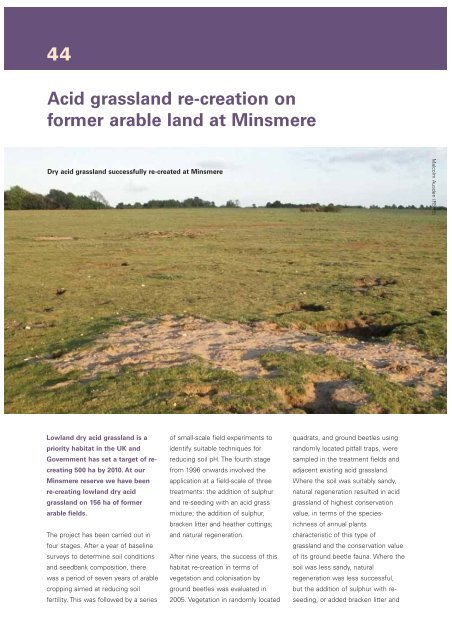Conservation Science in the RSPB 2006
Conservation Science in the RSPB 2006
Conservation Science in the RSPB 2006
Create successful ePaper yourself
Turn your PDF publications into a flip-book with our unique Google optimized e-Paper software.
44<br />
Acid grassland re-creation on<br />
former arable land at M<strong>in</strong>smere<br />
Dry acid grassland successfully re-created at M<strong>in</strong>smere<br />
Malcolm Ausden (<strong>RSPB</strong>)<br />
Lowland dry acid grassland is a<br />
priority habitat <strong>in</strong> <strong>the</strong> UK and<br />
Government has set a target of recreat<strong>in</strong>g<br />
500 ha by 2010. At our<br />
M<strong>in</strong>smere reserve we have been<br />
re-creat<strong>in</strong>g lowland dry acid<br />
grassland on 156 ha of former<br />
arable fields.<br />
The project has been carried out <strong>in</strong><br />
four stages. After a year of basel<strong>in</strong>e<br />
surveys to determ<strong>in</strong>e soil conditions<br />
and seedbank composition, <strong>the</strong>re<br />
was a period of seven years of arable<br />
cropp<strong>in</strong>g aimed at reduc<strong>in</strong>g soil<br />
fertility. This was followed by a series<br />
of small-scale field experiments to<br />
identify suitable techniques for<br />
reduc<strong>in</strong>g soil pH. The fourth stage<br />
from 1996 onwards <strong>in</strong>volved <strong>the</strong><br />
application at a field-scale of three<br />
treatments: <strong>the</strong> addition of sulphur<br />
and re-seed<strong>in</strong>g with an acid grass<br />
mixture; <strong>the</strong> addition of sulphur,<br />
bracken litter and hea<strong>the</strong>r cutt<strong>in</strong>gs;<br />
and natural regeneration.<br />
After n<strong>in</strong>e years, <strong>the</strong> success of this<br />
habitat re-creation <strong>in</strong> terms of<br />
vegetation and colonisation by<br />
ground beetles was evaluated <strong>in</strong><br />
2005. Vegetation <strong>in</strong> randomly located<br />
quadrats, and ground beetles us<strong>in</strong>g<br />
randomly located pitfall traps, were<br />
sampled <strong>in</strong> <strong>the</strong> treatment fields and<br />
adjacent exist<strong>in</strong>g acid grassland.<br />
Where <strong>the</strong> soil was suitably sandy,<br />
natural regeneration resulted <strong>in</strong> acid<br />
grassland of highest conservation<br />
value, <strong>in</strong> terms of <strong>the</strong> speciesrichness<br />
of annual plants<br />
characteristic of this type of<br />
grassland and <strong>the</strong> conservation value<br />
of its ground beetle fauna. Where <strong>the</strong><br />
soil was less sandy, natural<br />
regeneration was less successful,<br />
but <strong>the</strong> addition of sulphur with reseed<strong>in</strong>g,<br />
or added bracken litter and

















